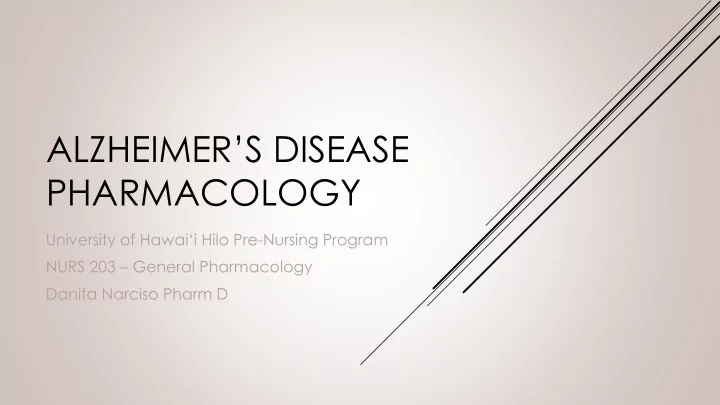

ALZHEIMER’S DISEASE PHARMACOLOGY University of Hawai‘i Hilo Pre -Nursing Program NURS 203 – General Pharmacology Danita Narciso Pharm D
Understand how the proposed hypotheses for Alzheimer’s Disease explains the drugs used to treat the symptoms Know which drugs belong to which class in the treatment of Alzheimer’s disease Understand the pharmacologic differences between cholinesterase inhibitors that give individual drugs a place in therapy Know the pharmacologic characteristics of NMDA inhibitors and how they work for Alzheimer’s Disease LEARNING OBJECTIVES
Review of Alzheimer’s Disease Hypotheses surrounding Alzheimer’s Disease Drugs used to treat Alzheimer’s disease OVERVIEW
Neurodegenerative disease associated with Impaired memory 1. Plaques 2. Neurofibrillary tangles Difficulty recognizing people, stimuli, & objects 3. Atrophy of brain areas Impaired writing & speech abilities 4. Decrease in acetylcholine Depression, aggression, moodiness 5. Excessive glutamate Impaired motor skills WHAT IS ALZHEIMER’S DISEASE?
sAPP Amyloid Alpha secretase 1. Precursor Neuronal growth Proteins Neuronal survival Synaptic health N-APP Beta secretase 2. Axon health through selective apoptosis (DR6 receptor) 1 3 Gamma secretase 3. A β 2 Formation of plaques Inflammation Death receptor activation Reactive oxygen species UNDER NORMAL CIRCUMSTANCES
sAPP Alpha secretase 1. Neuronal growth Neuronal survival Too much N-APP Synaptic health Beta secretase 2. Excessive apoptosis Axon health through selective apoptosis (DR6 receptor) Gamma secretase 3. Formation of plaques N-APP Inflammation Death receptor activation Reactive oxygen species A β Too much A β Aggregates Forms Plaques WHAT MIGHT BE HAPPENING IN AD - PLAQUES
Under normal circumstances Alzheimer’s Disease Tao – Protein involved in the stabilization of microtubules τ τ P τ P τ P τ P τ P τ P τ P τ P Enzyme τ P τ P Microtubule τ P τ τ τ P τ P τ P τ P τ P τ P WHAT MIGHT BE HAPPENING IN AD - TANGLES
Under normal circumstances Alzheimer’s Disease Tao – Protein involved in the stabilization of microtubules τ τ P τ P τ P τ P τ P τ P τ P τ P Enzyme τ P τ P Microtubule τ P τ τ τ P τ P τ P τ P τ P τ P 1. Acetylcholine 2. A β 3. Glutamate (NMDA receptor) WHAT MIGHT BE HAPPENING IN AD - TANGLES
Cholinergic deficits Glutamate excess τ P Glutamate τ P Enzyme A β Na & Ca 1. Acetylcholine 2. A β Acetylcholine Activation of ATP 3. Glutamate (NMDA depletion the Calpain receptor) enzyme Apoptosis WHAT MIGHT BE HAPPENING IN AD – PLAQUES & TANGLES
Cholinesterase Inhibitors NMDA Antagonists Memantine (Namenda) Tacrine (Cognex) Donepezil (Aricept) Rivastigmine (Exelon) Galantamine (Razadyne) DRUGS USED TO TREAT ALZHEIMER’S DISEASE
CHOLINESTERASE INHIBITORS
ADRs MOA – Centrally active reversible Nausea, vomiting, diarrhea, weight loss, dizziness, headache inhibitor of acetylcholinesterase Severe: hepatotoxicity Dosage forms – oral Interactions Kinetics Antipsychotics (increase in EPS), High first pass effect - ~17% oral inhibitors of CYP1A2 bioavailability (fluoroquinolones, antifungals, Food decreases drug cimetidine, fluvoxamine ) concentrations Bioavailabiltiy reduced by food Metabolism – CYP1A2, has an active metabolite Half-life – 2-4 hours Excretion - urine CHOLINESTERASE INHIBITORS - TACRINE
MOA – Reversible and noncompetitive ADRs inhibitor of central acetylcholinesterase Insomnia, nausea, vomiting, diarrhea, Dosage forms infection, accidental injury, headache, dizziness, weight loss, fatigue, arrhythmia, Oral – 10 mg & 23 mg tablet, ODT 5mg &10 rhabdomyolysis mg Interactions Kinetics Anticholinergic & cholinergic medications, Absorption – well absorbed beta blockers, inhibitors of CYP2D6 & 3A4, statins Distribution – large Vd, lipophilic Pregnancy category - C Protein binding – 96% Breast milk – not known Metabolism – extensive via CYP2D6 & 3A4, metabolites (inactive & active) Half-life – 70 hours (15 days to steady state) Time to peak – 3 hours, 8 hours Excretion – urine 57% (17% unchanged drug), feces 15% CHOLINESTERASE INHIBITORS - DONEPEZIL
MOA – Reversible inhibition of the ADRs hydrolysis of acetycholine by cholinesterase Headache, agitation, falling, weight loss, nausea, vomiting , diarrhea, abdominal Dosage forms pain, tremor, fatigue, insomnia, confusion, dyspepsia, UTI Oral – tablet & solution Transdermal Transdermal patch decreased incidence of ADRs overall Kinetics Redness at application site Absorption – oral, rapid & complete Interactions (fasting), transdermal 30-60 minutes Protein binding - ~40% Avoid use with beta blockers (other agents that can cause bradycardia), avoid use Metabolism – hydrolysis by cholinesterase with metoclopramide , cholinergic agents & in the brain, demethylation & conjugation anticholinergic agents, antipsychotic in the liver (minimal CYP) agents (severe EPS) Half-life – oral 1.5 hours, patch ~ 3 hours Pregnancy category – B upon removal Breast milk – not known Time to peak – oral 1 hour, patch 6-8 hours after applied Food delays absorption but increases bioavailability Excretion – urine (97% metabolites) CHOLINESTERASE INHIBITORS - RIVASTIGMINE
MOA – Competitive & reversible ADRs central cholinesterase inhibitor, may also increase glutamate & serotonin Nausea , vomiting, headache, levels diarrhea, weight loss Interactions Dosage forms Anticholinergics & cholinergic agents, Oral – solution & tablet (IR & ER) antipsychotics, beta blockers & other Kinetics agents that slow heart rate (high incidence of interaction with drugs Distribution – large that prolong QT interval) Protein binding – low Pregnancy category – C Metabolism – CYP2D6 & 3A4 (minor) Breast milk – not known Bioavailability – 90% Half-life – 7 hours Time to peak – 1 hour (2.5 with food), 4.5-5 hours Excreted – urine (20%) CHOLINESTERASE INHIBITORS - GALANTAMINE
MOA – noncompetitive antagonist of the N-methyl-D-aspartate (NMDA) receptor for glutamate, decreases glutamate activity under conditions of excessive excitation (does not ADRs effect normal neurotransmission), Hypertension & hypotension (IR/ER), antagonized 5HT & nicotinic dizziness, confusion, headache, receptors, agonist at DA receptors anxiety, diarrhea, constipation Dosage forms Interactions Oral – solution & tablet (IR&ER) Minor Kinetics Pregnancy category – B Absorption – well absorbed Breast milk – not known Protein bound - ~45% Metabolism – Liver (not CYP), minor - inactive metabolites Half-life – 60-80 hours Time to peak – 3-7 hours, 9-12 hours (IR/ER) Excretion – urine (unchanged) NMDA ANTAGONISTS - MEMANTINE
Recommend
More recommend